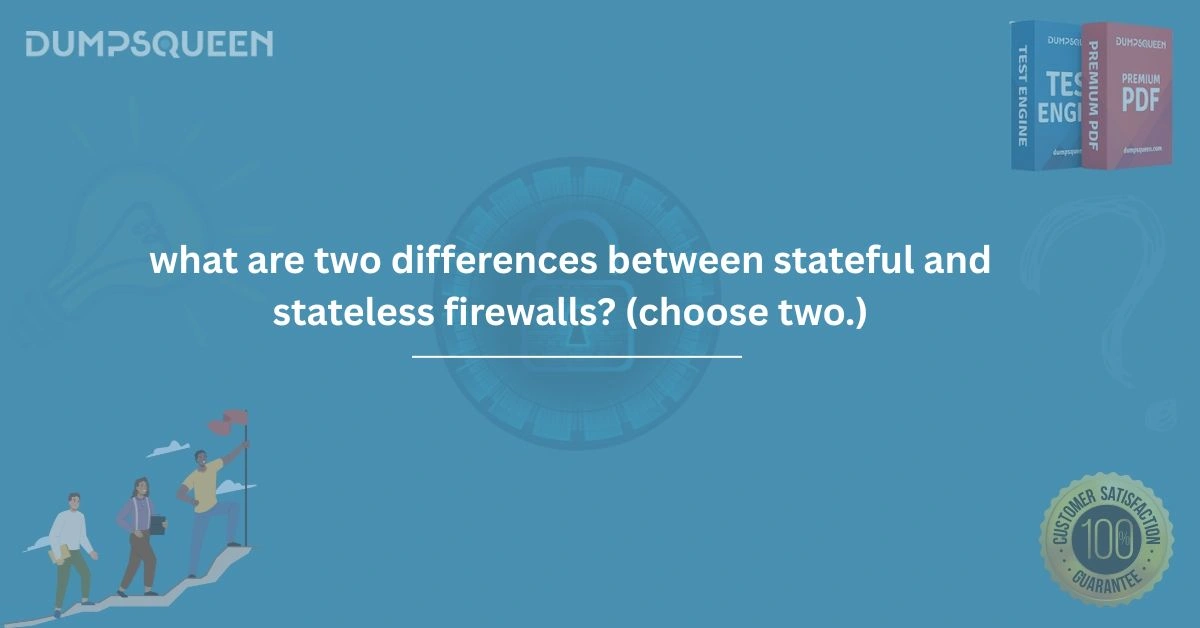Introduction
In the evolving landscape of cybersecurity, firewalls remain a crucial line of defense between trusted internal networks and potentially malicious external environments. Organizations across the world rely on firewalls to protect data, enforce security policies, and ensure operational continuity. As technology advances, the complexity and capabilities of firewalls have also progressed. Two significant types of firewalls commonly implemented today are stateful firewalls and stateless firewalls. Understanding the distinction between these two firewall types is essential not only for network security professionals but also for those preparing for certification exams such as Cisco, CompTIA, or other network security credentials. The question "what are two differences between stateful and stateless firewalls? (choose two.)" is a common format used in certification exams to test conceptual clarity. In this blog presented by DumpsQueen, we will deeply explore the operational characteristics, behavioral differences, and practical implications of stateful and stateless firewalls. The goal is to provide a comprehensive explanation of the differences that define how these firewalls function and where they fit in modern networks.
The Role of Firewalls in Network Security
A firewall acts as a barrier between internal and external networks. It inspects incoming and outgoing packets based on predetermined security rules and decides whether to allow or block traffic. Firewalls are implemented in both hardware and software and serve as the gatekeepers of network boundaries. In corporate environments, firewalls help prevent unauthorized access to internal systems, limit the exposure of sensitive information, and enable organizations to comply with regulatory standards. Two major types of firewalls that differ in terms of functionality and efficiency are stateful and stateless firewalls. While both types aim to enhance security, their approach to handling traffic is vastly different.
What Is a Stateless Firewall?
A stateless firewall is one of the earliest forms of firewall technology. It works by examining each packet individually without considering the context or the traffic flow. In other words, a stateless firewall treats every incoming or outgoing packet in isolation. These firewalls use simple, static rules to determine whether to permit or deny traffic. They do not track connection states, which makes them relatively fast but limited in terms of decision-making. Stateless firewalls are best suited for environments where speed and simplicity are prioritized, such as small office networks or in front of load balancers.For instance, if a stateless firewall sees a TCP SYN packet, it doesn’t remember it as part of a connection attempt. It applies rules and either forwards or drops the packet without tracking what happens next.
What Is a Stateful Firewall?
Unlike stateless firewalls, stateful firewalls inspect traffic with context. They track the state of active connections and determine whether an incoming packet is part of an existing connection or a new one. Stateful firewalls maintain a state table that records details of each active session, including IP addresses, port numbers, and the connection status. This connection-aware design allows stateful firewalls to make smarter security decisions. For example, if a client initiates a request to a web server, the stateful firewall will allow the return traffic from the server without requiring an explicit rule for the server's response. Stateful firewalls are widely used in enterprise environments where complex applications and high-value data require a robust security mechanism capable of understanding network traffic behavior over time.
Deep Comparison: Stateful vs. Stateless Firewalls
To answer the question "what are two differences between stateful and stateless firewalls? (choose two.)", we need to go beyond definitions and explore core differences. The two key distinctions lie in connection tracking and performance vs. intelligence.
Connection Awareness and Context Tracking
This is one of the most important differences.
Stateful firewalls maintain records of every connection passing through the firewall. They know which packets are part of which session, and they track the initiation, progress, and termination of each connection. This allows them to make intelligent decisions about which packets to allow or block.On the other hand, stateless firewalls do not maintain any connection information. They evaluate each packet on a standalone basis, which can sometimes lead to less accurate filtering or require more complex rule sets to handle scenarios like return traffic. For example, consider a user accessing a website. A stateful firewall knows that an outbound request was made to the site and will automatically allow the response back in. A stateless firewall, however, needs a separate rule to permit the incoming response, otherwise it may block the return packet.
Speed and Performance Efficiency
Another key difference is performance.
Stateless firewalls are faster because they don't keep track of session states. This makes them ideal for high-throughput environments where large volumes of traffic must be processed quickly without deep inspection. Stateful firewalls, due to their detailed traffic inspection and session monitoring, tend to require more resources. They may be slightly slower but offer enhanced security capabilities. This trade-off between speed and intelligence often dictates which type of firewall is best for a specific network architecture. In highly sensitive environments, the slower but smarter choice (stateful) is preferred. In others, especially those needing rapid packet processing like DNS queries, stateless firewalls might be better.
Rule Configuration and Management
Another distinction lies in how administrators create rules.
With stateless firewalls, administrators must define rules for every possible direction of traffic. This means creating rules for both incoming and outgoing packets, even for the same session. Stateful firewalls simplify rule management by automatically handling return traffic for established sessions. This means fewer rules and easier management, especially in large-scale environments. This difference becomes significant in dynamic enterprise environments where the number of services and ports can vary frequently.
Security and Threat Detection
From a security standpoint, stateful firewalls are more advanced. They can recognize suspicious behavior like unexpected responses or incomplete handshakes and block them accordingly. Stateless firewalls, while still capable of basic filtering, cannot detect these types of threats since they do not understand connection states. This makes them less effective against complex attacks like TCP SYN floods or session hijacking. Thus, in an enterprise-grade threat model, the enhanced awareness of stateful firewalls is a major advantage.
Real-World Deployment Scenarios
Organizations often use both types of firewalls in a layered approach. For example, a stateless firewall might be placed at the perimeter to quickly filter obvious malicious traffic, while a stateful firewall provides deeper inspection at internal boundaries. Cloud service providers and data centers also leverage stateless firewalls in front-end load balancers to reduce latency, followed by stateful firewalls to inspect the application layer traffic.Understanding where and how to use each firewall type is critical for designing secure, scalable networks.
Why This Matters in IT Certification Exams
For certification candidates, especially those pursuing Cisco's CCNA or CompTIA Security+, questions like "what are two differences between stateful and stateless firewalls? (choose two.)" are commonly seen in multiple-choice formats. Exams test not only theoretical knowledge but also the ability to apply concepts in real-world scenarios. Knowing the behavior of each firewall type helps in answering such questions with confidence and accuracy. At DumpsQueen, our study guides and dumps provide up-to-date practice questions tailored for these types of exams. Our materials are designed by certified professionals to ensure alignment with the current exam blueprints.
DumpsQueen’s Role in Your Certification Journey
Whether you're preparing for Cisco 200-301 (CCNA) or CompTIA Security+ SY0-701, understanding firewall fundamentals is essential. DumpsQueen offers a comprehensive library of real exam questions, verified answers, and scenario-based practice materials that reflect current exam standards. With our resources, candidates gain not only theoretical clarity but also practical confidence. Choosing DumpsQueen means choosing reliability, authenticity, and a pathway to certification success.
Free Sample Questions
Question 1: What are two differences between stateful and stateless firewalls? (Choose two.)
A. Stateless firewalls track active connections; stateful do not.
B. Stateful firewalls offer higher context-based security.
C. Stateless firewalls are faster in packet processing.
D. Stateful firewalls require rules for each traffic direction.
Correct Answers: B, C
Question 2: Which of the following is true about stateless firewalls?
A. They can detect and block SYN flood attacks.
B. They store session details in a state table.
C. They evaluate each packet in isolation.
D. They offer better protection for dynamic networks.
Correct Answer: C
Question 3: In which scenario would a stateless firewall be more appropriate?
A. Deep packet inspection in a secure database environment
B. Rapid DNS resolution at the network perimeter
C. Preventing malware in encrypted tunnels
D. Detecting anomalies in TCP handshakes
Correct Answer: B
Question 4: What is stored in the state table of a stateful firewall?
A. Only port numbers and MAC addresses
B. The routing table of the firewall
C. Connection session details including IP, port, and protocol
D. Static rules for packet filtering
Correct Answer: C
Conclusion
In the battle between performance and intelligence, stateless and stateful firewalls offer different but complementary benefits. Understanding what are two differences between stateful and stateless firewalls? (choose two.) helps you grasp how modern network security is structured. Stateless firewalls prioritize speed and simplicity, while stateful firewalls focus on depth and intelligence. Both are necessary depending on the network’s goals, structure, and threat environment. For professionals preparing for network security certifications, mastering these differences is more than just answering a multiple-choice question it’s about securing real-world networks efficiently. At DumpsQueen, we support your certification goals with expertly curated resources that simplify complex concepts and prepare you for success. Explore our collection today and take the next confident step toward your IT future.




